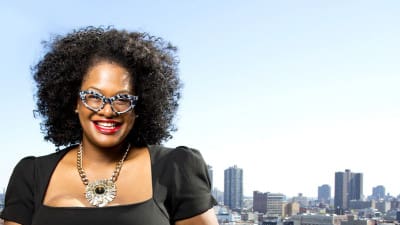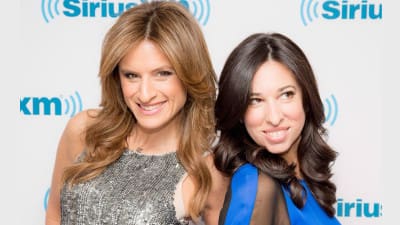If you live in Any Metropolis, USA, coming out of the neighborhood coffee shop with a frappuccino and a cheese danish for less than $20 can be a study in quantitative economics. So buying an entire outfit that’s both street legal and stylish for the same price seems more than a little unlikely.
Kathryn Finney proves that it can be done. And she doesn’t just do it herself — she teaches readers of her uber-popular blog, The Budget Fashionista, how to do it too. Growing from a hobby to a respected resource racking up more than a million monthly hits, TheBudgetFashionista.com has made Finney, a former epidemiologist, into a multimedia maven — and a wealthy one at that.
Recently named one of AOL’s Top 10 Women in Money, she’s written a bestselling book, How to be a Budget Fashionista: The Ultimate Guide to Looking Fabulous for Less, and has been featured in more than 600 magazines, all based on one fundamental concept: being stylish has nothing to do with how much you spend but how well you wear what you have. Now, Finney is the founder and managing director of digitalundivided, a social enterprise helping urban entrepreneurs build companies.
Here, the native Midwesterner talks about her entrepreneurial path, building her personal brand, and why her blood runs red for Target.
How did you create the concept for The Budget Fashionista?
At the time, I was living in Philly, and I was broke. All my friends lived in New York, so I would spend time at the King of Prussia Mall and Franklin Mills [Mall] and I would come to the city and go to sample sales. And sometimes I wouldn’t even buy, but I would just write about the stuff that I was seeing or how I was able to do an outfit on $20. I would go into the stores and watch other people shop and talk to the associates and see when they put things on sale and [ask], ‘How can I get this coupon even though I don’t have the credit card?’ I would just use that for content in the blog.
So how did you use a multimedia platform to grow it and get your name out there? How does everything flow together?
The way we tie it all together is just being really consistent in the message, which is real fashion for real women with real budgets. So whether I’m on the Today show or writing for the site, the message doesn’t change. I go to the outlets. If you see me on the street, what I’m wearing, I got on sale. I don’t write about $5 jeans from Wal-Mart and wear $5,000 shoes.
That’s not who I am. Me being the spokesperson for the site and being The Budget Fashionista also helps connect everything because I don’t look like a lot of my friends who are “fashion experts.” I’m very much a real woman. The fact that I look different definitely helps tie the brand across all the different platforms we operate.
What would you say was the pivotal point in your entrepreneurial journey, when things really started to take off?
I worked full-time up until we got the book deal in 2004 because that’s when I realized that this was a serious business. I was like, ‘OK, I’m getting a substantial amount of money to write a book on this. This is real.’ That’s when I started to do The Budget Fashionista full-time. I’m the CEO.
I always have to explain that to people because they’re like, ‘Oh, you’re a blogger’ and I’m like, ‘No, not really. I do write for the blog, but there’s a lot of other stuff that we do.’ There are other projects I’m working on like the book and television, and we’re also working on a line for one of the shopping networks. So it’s a company.
You had great support from your family and friends when you started, but did you have professional roadblocks or obstacles?
Oh, of course. I’m a big black woman from the Midwest running a media company. That alone should tell you. It’s like sure, do I get road-blocked? Of course. Do people have problems because of my identity? Sure. Do I let it stop me? Hell no. And you just have to sort of realize that’s their problem, not yours, and push forward. And that’s what I’ve done.
Recession and budget-friendly topics are in vogue right now. How have you been able to stave off competitors?
For one, I shop at Wal-Mart. I shop at Target. A lot. I’m from Minnesota. That’s where Target’s from, so it’s in my blood. So when I write or go on television, I know what I’m talking about. It’s not some assistant writing notes for me. And while we do have a showroom for these stores and these brands, I actually prefer to go in the store. I like to see what the consumer is buying. What do you buy when you go into Wal-Mart or Target or H&M? What are you getting there?
Because I can go into the showroom and see the stuff, which is great, and the publicist will give me their shpiel. But that’s not the same as what you the consumer buy. For two, we maintain relationships with people. We try to be fair. We might not always write what they want us to write, but our criticisms are fair.
Is there anything you would have done differently now in retrospect as you built The Budget Fashionista?
When I started, there was no roadmap. The Internet was kind of like the poor, bastard cousin — I won’t even say child — of the media family. No one really gave a crap about us. I think what I probably would have done is focus on building more relationships sooner with some of the online properties and print. There’s so many things I would’ve done different in hindsight but yet, it’s all led me here. So I have to have an appreciation for the mistakes.
What’s been your biggest fashion faux pas in the past?
There was a story about me in The New York Times when my husband and I moved from Philadelphia to New York. Look at that picture and you’ll see. It’s that and if you go on my YouTube page, my very first Today show, I seriously looked like a clown slash drag queen.
It was scary. I had somebody do my makeup who didn’t know anything about doing makeup for television. This all happened within a week of each other. And then finally, I sat down with a friend who does a lot of television and he helped me map out a look.
What are some things that other people do that absolutely drives you crazy?
I hate, hate, hate those low-rise jeans that I see young women wearing and sort of stuffing themselves into. Like, you need a bigger size. And the whole hipster look, I just feel like they’re trying too hard to be sort of like grungy dirty. It’s like, ‘Oh look at me, I wear my plaid shirt and my skinny jeans. Look, I’m ironic. I wear a trucker hat.’ I feel like they’re trying too hard to have a look. Other than that… maybe jeggings, because I just think they’re stupid.
Online advertising has taken a real hit, and many sites are going back to instituting paywalls. What are your sites’ main sources of income — anything outside of just display ads?
Well, we do a lot of stuff offline. I have spokesperson relationships with Marshall’s, TJ Maxx. I’ve worked for Sears, PayPal, Charming Shops, Payless — I mean, you name it, we have people that we’ve worked with. We’ve done social media campaigns, I’ve done television campaigns. I just did a big TV thing for Tide for their Tide to Go pen. We’ve really diversified. Online is my bread and butter, that’s my foundation, it’s where I come from. But it’s not the only thing that I do.
Kathryn Finney’s tips for establishing yourself as a fashion expert:
1. Do your homework. “Fashion isn’t just, ‘Oh, I’m a great shopper.’ You need to understand the human body and be able to assess what looks good on someone else.”
2. Design and style for people. “If you can’t get anybody to pay you, ask your family or friends if you can do it [for them] for free. You’ll gain firsthand knowledge on how to dress and work with real women.”
3. Be original. “Assess what’s already out there and ask real people — not family members — what they think of your idea. If no else is buying into it, then your idea is probably not as good as you think it is.”
4. Make connections. “Get a mentor and try to meet as many people in the industry as you can.”
5. Get a life. “A lot of my ideas I get when I’m not [online], just enjoying life and being present and spending time with the people that I love and care about.”
This interview has been edited for length and clarity.











